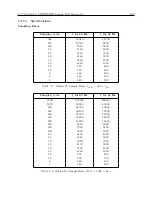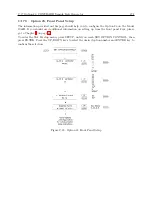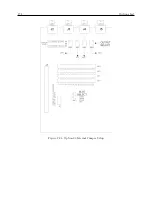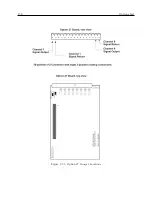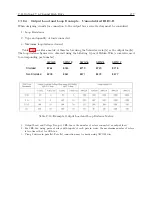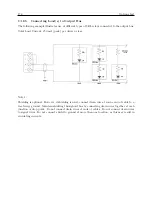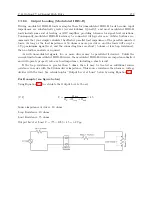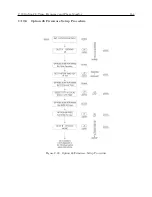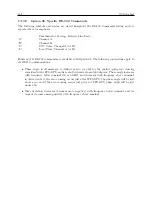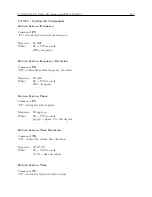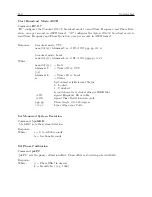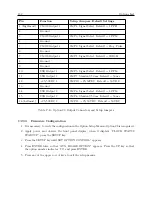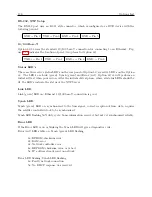
C.19 Option 28: Time, Frequency and Phase Monitor
181
Using RS-232C Port
To set up Option 28 using the RS-232C port, please follow the guidelines in Section 9.2.13 on
page 90.
Viewing Option 28 Information
View the deviations on the front panel display as follows:
1. To view the System voltage and phase angle, press the EVENT/DEVIATION key on the
front panel:
System Input 114.91 V
Phase 359.60
◦
2 To view ∆ F and ∆ T, press the EVENT/DEVIATION key a second time:
System ∆ F -0.0010 Hz
∆ T +0.0000 Sec
3 To view System frequency and time, press the EVENT/DEVIATION key a third time:
System Frq 59.993 Hz
Time 19:39:25.4327
NOTE:
Selection of Option 28 results in the deactivation of the Event front panel displays. The
event displays may be re-enabled if desired, by entering the SET EVENT/DEVIATION menu and
following the procedure below. This choice is only available when Option 28 is installed in the unit.
4 Use the SETUP key and access the SET EVENT DEVIATION? setup menu. Press ENTER
to display the following:
DISPLAY OPT 28 ONLY?
UP = YES DOWN = NO
5 To view Option 28 only, press the UP key, then press the front panel key EVENT /DEVIA-
TION to display Option 28 measurement information.
6 To enable Event/Deviation A and B displays as well, press the DOWN key and config-
ure the Channel Mode, Time, and Recorder Channel.
Then press the front-panel key
EVENT/DEVIATION to sequentially display all three channels. For a detailed description,
refer to Section 5.2.2.
C.19.5
Calibration
The clock is now configured for operation. Calibration for phase and amplitude are not necessary for
most applications, however if necessary, can be performed. Specifically, these calibrations have no
effect on system time and frequency measurements, and are unnecessary if only time and frequency
are required.
Uncalibrated phase accuracy is usually less than 0.3 degree, and can be reduced to 0.1 degree typical
and 0.2 degree guaranteed with calibration. Uncalibrated amplitude accuracy is usually less than
1%, which is the typical performance of this measurement. Amplitude accuracy is not guaranteed,
and amplitude measurements are provided primarily to verify that the unit is properly connected
and receiving the expected signal level.
Summary of Contents for 1088A
Page 4: ...iv ...
Page 6: ...vi ...
Page 18: ...xviii LIST OF FIGURES ...
Page 23: ...1 4 Attaching Rack Mount Ears to 1088A B Series Clocks 3 Figure 1 2 Attaching Rack Mount Ears ...
Page 24: ...4 Unpacking the Clock ...
Page 32: ...12 Front and Rear Panels ...
Page 38: ...18 Connecting Inlet Power Input and Output Signals ...
Page 46: ...26 GPS Antenna and Cable Information ...
Page 48: ...28 Setting Internal Jumpers Figure 5 1 Model 1088B Main Board ...
Page 76: ...56 The Setup Menus ...
Page 112: ...92 Serial Communication and Command Set ...
Page 127: ...B 4 Physical Dimensions 107 Figure B 1 Suggested Mounting of the AS0094500 Surge Arrester ...
Page 128: ...108 Using Surge Arresters ...
Page 145: ...C 5 Option 04 Parallel BCD Output 125 Figure C 4 Option 04 Output Jumper Settings ...
Page 146: ...126 Options List Figure C 5 Option 04 Board Layout and Jumper Locations ...
Page 166: ...146 Options List Figure C 12 Option 17 Board Layout and Jumper Locations ...
Page 187: ...C 16 Option 20A Four Fiber Optic Outputs 167 Figure C 22 Option 20A Jumper Locations ...
Page 194: ...174 Options List Figure C 24 Option 23 Internal Jumper Setup ...
Page 196: ...176 Options List Figure C 25 Option 27 Jumper Locations ...
Page 214: ...194 Options List Figure C 28 Option 29 Connector Signal Locations ...
Page 270: ...250 Options List ...



